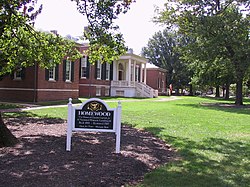Homewood Museum
|
Homewood
|
|

Homewood Museum on the Johns Hopkins University campus
|
|
| Location | Baltimore, Maryland |
|---|---|
| Coordinates | 39°19′46″N 76°37′9″W / 39.32944°N 76.61917°WCoordinates: 39°19′46″N 76°37′9″W / 39.32944°N 76.61917°W |
| Built | 1801 |
| Architectural style | Federal, Other |
| NRHP Reference # | 71001033 |
| Significant dates | |
| Added to NRHP | September 10, 1971 |
| Designated NHL | November 11, 1971 |
The Homewood Museum is a historical museum located on the Johns Hopkins University campus in Baltimore, Maryland. It was listed as a National Historic Landmark in 1971. It, along with Evergreen Museum & Library, make up the Johns Hopkins University Museums.
The Homewood Estate was offered as a wedding gift in 1800 by Charles Carroll of Carrollton, (1737-1832), the longest surviving signer of the Declaration of Independence, to his son Charles Carroll Jr. It occupied 140 acres (57 ha) acres in northern Baltimore and was first known as "Merryman's Lott." Carroll had purchased the parcel of land in 1794. Charles Carroll Jr. began construction on a stately and modern country home of his own design in 1801 and had mostly finished by 1808. It cost $40,000, four times the budgeted expense. For reasons both personal and political, "Homewood" led to a severe breach in relations between father and son. Ultimately, Carroll (Senior) bought the house from his son in 1824 and managed the "most improvident waste" until his son's death the next year. The house then passed to Charles Carroll III, (the grandson), who lived there until he inherited the rural landmark family estate, Doughoregan Manor (in modern Howard County), from his grandfather.
The house was the birthplace of John Lee Carroll in 1830, second son of Charles Carroll, III, who would become Governor of Maryland. In 1839, Charles Carroll III sold Homewood to Samuel Wyman, a Baltimore merchant, who lived there with his family until 1865. During the Wyman family's tenure, Wyman's son William commissioned Richard Upjohn to build an Italianate mansion on the grounds, named "Homewood Villa." The Villa was demolished by Johns Hopkins University in 1954; however, the gatehouse to the estate remains, and can be seen as an example of the villa design. On Samuel Wyman's death the property was divided between his sons. In 1897, Homewood House became the first Gilman School, known at its founding as The Country School for Boys. In 1902 the property was reassembled and given to Johns Hopkins University.
...
Wikipedia



